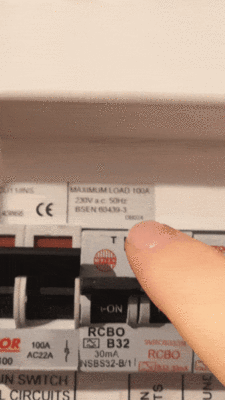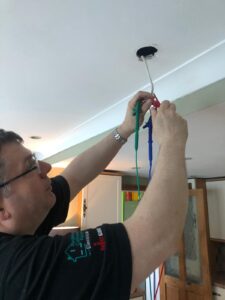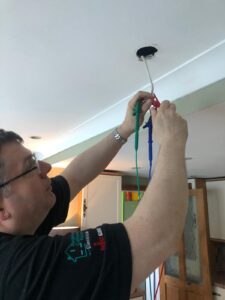I recently attended a customer to fit a replacement porch light. The alarm bells started ringing when I opened the switch and found the earth wires cut off, this is always a bad sign.
Further investigation and testing showed that there was no continuous earth on the house lighting circuit further than the first light fitting and even that section of earthing had an insulation problem.
This is why it is so important that electrical work is properly inspected, tested and certificated when it is completed. The testing that is required needs undertaking with proper equipment (it costs hundreds sometimes thousands) and requires an electrician that is competent to use it. It is not good enough to get Dave down the pub with his 20-year-old Maplin multimeter to have a look.
Given the house was fitted with metal light switches and metal light fittings this lack of earthing would have made the installation very dangerous in the event of a fault, earthing is there to protect you when something goes wrong. There was not even an RCD to provide any additional protection.
I started investigating the lighting circuit further, removing all switches and light fittings. The full extent of the problem started to be revealed. If the earthing wires (know to us sparks as CPC’s) had not been deliberately chopped off they were crudely twisted together with no proper terminal.
One light fitting was not fixed to the ceiling by anything more than paint, another just had a piece of flex cut off an small appliance such as a radio poking out of the ceiling with the light fitting connected to it, no sign of an accessible junction box or ceiling rose. Out in the kitchen however the wiring was much newer, the cable colours indicate that the wiring had been done since 2004, a test quickly showed that the earthing fault was present there also.
At this point I had no alternative than to start lifting floors and cutting into the kitchen ceiling to find the hidden junction boxes. Inside the kitchen ceiling was a junction box with loose terminals, this was totally inaccessible having been covered by the ceiling on one side and a ceramic tiled floor on the other.
The light with the radio flex sure enough had the remnants of an old ceiling rose under the floor with no cover on it, the live terminals just siting in a pile of wood shavings, fiberglass and other detritus under the floor.
Having remade all these junctions properly in maintenance free junction boxes (they type that can be hidden under floors if you really have no alternative) and connected all the earths back up at the switches and ceiling roses the earth fault still remained.
There must have been another hidden junction box. Given the cable runs I was able to make an educated guess as to where it might have been hidden, sure enough under the hall floor there it was, approximately 40 years old and looked like it had never been touched since it was installed.
I opened it up and there was my last remaining fault, all the earth cables just stuffed in there with no screw on the terminal that should have been connecting them all together.
The person who had fitted it in the 70’s or 80’s has obviously lost the screw and decided to simply put the lid on the box and forget all about it, the fault had been there for the entire life of the wiring system.
Along with the nail through the cable that he had done when he put the floorboard back down after throwing his wires in.
So this install was obviously never tested for proper function when it was installed, a DIY job probably.
“Bad electrics from the 70’s that’s not an unusual thing” I hear you cry, well first of all the decade of install is no excuse for such a bad workmanship but much worse is the fact that the house has had wiring work done since.
The consumer unit is less than 20 years old and certainly not as old as the fault I have just found, the kitchen wiring is a maximum of 16 years old and by the looks of the kitchen it’s not 5 years since it was fitted.
Did the person who put the new consumer unit in test it, I doubt it or he would have found this fault.
Did the kitchen fitter get a proper electrician to install the new kitchen wiring? If so, presumably they tested their work, so why did this spark not see the fault that I found and get it fixed?
Or did the kitchen guy just do the work himself and the only testing that was done was to turn the lights on and marvel at the glowing bulbs with no thought at all put to the effectiveness of the earthing system which is there to save your life when something goes wrong.
These seem to be the only possibilities, and they are all negligent.
My customer now has a working porch light but far more importantly (in my mind) a working earthing system.
I tested the rest of the house and found another fault on a hidden junction box on the socket circuit, when I found the junction it was undersized and only rated for 20amps of load, this was being used on a 32amp socket circuit.
My customer will now spend days putting their house back together as we had to move nearly all of their furniture to open the floors and find all of the faults.
The moral of this story is twofold. Firstly electricity is not a DIY job, if I had my way I would stop DIY shops selling electrical equipment, secondly if you have work done that involves new wiring you should be getting a certificate from the electrician that shows the work has been inspected and tested. This certificate gives you a copy of all of the test results, you should keep these certificates just like you would keep the service history of your car.
Finally if you haven’t got any certificates for your house wiring or its ten years since it was last tested, its probably time to give me a call and get a test done, I warn you though, if I find safety critical problems I’m going to want to get them fixed.













